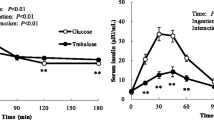Summary
To confirm findings obtained from animal experiments demonstrating the metabolic effect of two new glucosidase inhibitors, 7 single blind cross-over studies with 42 healthy male volunteers were performed. In each group 6 subjects received 25, 50, 100 and 200 mg BAY m 1099 and 10, 20, and 40 mg BAY o 1248 or placebo with a standardized breakfast. Blood glucose and serum insulin were measured in venous blood before and 30, 60, 90, 120 and 180 min after each of 3 meals. ECG, blood pressure, body weight, monitor ECG and haematological and clinico-chemical parameters were also examined.
The postprandial increase in blood glucose and serum insulin after breakfast were significantly and dose-dependently reduced by BAY m 1099.
10 and 20 mg BAY o 1248 not only reduced the increases in blood glucose and serum insulin after breakfast, but also after lunch (10 mg). 40 mg BAY o 1248 prevented the postprandial increase in both metabolic parameters after breakfast (p<0.05), an effect which was sustained after lunch.
Intestinal problems occurred (flatulence, meteorism, diarrhoea) in 25 of 42 volunteers. Objective tolerability was good.
The results of these first clinical pharmacological studies with two new glucosidase inhibitors justify studies on patients with diabetes mellitus.
Similar content being viewed by others
References
Bachmann W, Rinninger F (1985) Improved metabolic control in type I diabetic patients after treatment with the glucosidase inhibitor BAY m 1099. Diabetes 34 (suppl 1): Abstract 751
Bryce GR, Scott DT, Carter MW (1980) Estimation and Hypothesis Testing in Linear Models — A Reparameterization Approach to the Cell Means Model. Communications in Statistics — Theor Meth A9 (2):131–150
Creutzfeldt W (1982) (Ed.) Proceedings — First International Symposium on Acarbose. Excerpta Medica, Amsterdam-Oxford-Princeton
Fölsch UR, Lembcke B, Lücke B, Hillebrand I, Ebert R, Creutzfeldt W (1984) Wirkung semisynthetischer Glucosidaseinhibitoren (BAY o 1248 und BAY m 1099) auf Glucose, GIP und Insulin im Serum nach oraler Saccharosegabe. Akt Endokrin 5:87
Hillebrand I, Boehme K, Schulz H, Graefe KH, Wehling K, Fink H (1984) Akutuntersuchungen an gesunden Probanden mit den neuen Glucosidaseinhibitoren BAY m 1099 und BAY o 1248. Akt Endokrin 5:91
Junge B, Böshagen H, Kinast G, Köbernick H, Krause HP, Müller L, Puls W, Stoltefuss J (1984) BAY m 1099 — a newα-glucosidase inhibitor and potential antidiabetic agent. VIIIth International Symposium on Medicinal Chemistry, Uppsala, Sweden, Abstract L 42
Laube H, Mehlburger L, Federlin K, Hillebrand I (1984) BAY m 1099, ein neuer Enzyminhibitor mit blutzuckersenkender Wirkung. Akt Endokrin 5:103
Lembcke H, Fölsch UR, Creutzfeldt W (1985) Effect of l-desoxynojirimycin derivatives on small intestinal disaccharides activities and on active transport in vitro. Digestion 31:120–127
Müller L (1985) Microbial Glycosidase Inhibitors. In: Rehm H-J, Reed G (eds) Biotechnology. VCH Verlagsgesellschaft, Weinheim (Vol. 4, Capter 18, p 2–37)
Puls W, Krause HP, Müller L, Schutt H, Sitt R, Thomas G (1984) Inhibitors of the rate of carbohydrate and lipid absorption by the intestine. Int J Obes 8 (suppl 1):181–190
Raptis S, Dimitriadis G, Raptis A, Mitrakou A, Hatziagelaki E, Halvatsiotis P (1984) Effects of a new long-actingα-glucosidase inhibitor (BAY o 1248) on glycaemic control in insulin dependent diabetes mellitus. EASD, 20th Annual Meeting, London, Abstract 437
Schmidt FH (1961) Die enzymatische Bestimmung von Glucose and Fructose nebeneinander. Klin Wochenschr 39:1244
Taylor RH, Barker MH, Bowey EA, Canfield JE (1984 a) Intestinal monosaccharide transport is unimpaired by desoxynojirimycin-derived glycosidase inhibitors. Clin Sci 67:63P
Taylor RH, Barker HM, Bowey EA, Canfield JE (1984 b) Selective inhibition of intestinal disaccharide absorption by desoxynojirimycin-derived glycosidase inhibitors. Clin Sci 67:41–42P
Wide L, Porath J (1966) Radioimmunoassay of proteins with the use of Sephadex-coupled antibodies. Biochem Biophys Acta 130:257–260
Willms B, Schumann E, Arends J (1985) Comparative evaluation of two newα-glucosidase inhibitors (BAY m 1099 and BAY o 1248) in type-II-diabetics. Diabetes 34 (suppl. 1): Abstract 741
Author information
Authors and Affiliations
Rights and permissions
About this article
Cite this article
Hillebrand, I., Boehme, K., Graefe, K.H. et al. The effect of newα-glucosidase inhibitors (BAY m 1099 and BAY o 1248) on meal-stimulated increases in glucose and insulin levels in man. Klin Wochenschr 64, 393–396 (1986). https://doi.org/10.1007/BF01728191
Received:
Revised:
Accepted:
Issue Date:
DOI: https://doi.org/10.1007/BF01728191




